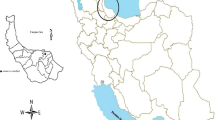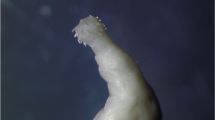Abstract
Habronema muscae is a spirurid nematode that undergoes developmental stages in the stomach of equids, causing chronic catarrhal gastritis. Despite preceding investigations have developed polymerase chain reaction (PCR)-based assays for molecular diagnosis, we aimed to assess the applicability of cytochrome c oxidase subunit 1 (cox1) sequences to identify the H. muscae infection and to assess the level of intraspecific variations in this parasite obtained from affected horses in Southern Iran. According to the morphological characterizations, two different isolates of H. muscae were identified. Although the majority of the recovered specimens had normal characterizations of H. muscae, a number of parasites showed an abnormal feature as large, asymmetrical, and thick cuticular extensions was observed at their anterior end (head region) in gross and histologic examinations. Unexpectedly, molecular assay disclosed that both morphologically distinct samples were completely identical to each other based on cox1 sequence. Multiple alignment of the cox1 amino acid sequences showed that all polymorphism sites were silent. Also, phylogenetic analysis provided strong support that H. muscae form a sister group to Spirocerca lupi and Thelazia callipaeda.



Similar content being viewed by others
References
Anderson RC (1957) The life cycles of dipetalonematid nematodes (Filarioidea, Dipetalonematidae): the problem of their evolution. J Helminthol 31:203–224
Anderson RC (2000) The superfamily Habronematoidea. In: Nematode parasites of vertebrates. Their development and transmission, 2nd edn. CABI, Guilford, pp 428–430
Anderson TJC, Blouin MS, Beech RN (1998) Population biology of parasitic nematodes: applications of genetic markers. Adv Parasitol 41:219–283
Blaxter ML, Floyd R (2003) Molecular taxonomics for biodiversity surveys: already a reality. Trends Ecol Evol 18:268–269
Blouin MS (2002) Molecular prospecting for cryptic species of nematodes: mitochondrial DNA versus internal transcribed spacer. Int J Parasitol 32:527–531
Blouin MS, Yowell CA, Courtney CH, Dame JB (1998) Substitution bias, rapid saturation, and the use of mtDNA for nematode systematics. Mol Biol Evol 15:1719–1727
Bowles J, Blair D, McManus DP (1992) Genetic variants within the genus Echinococcus identified by mitochondrial sequencing. Mol Biochem Parasit 54:165–174
Buzzell GR, Tariq S, Traversa D, Schuster R (2011) Morphology of the infective larval stage of the equid parasite Habronema muscae (Spirurida: Habronematidae), from houseflies (Musca domestica). Parasitol Res 108:629–632
Casiraghi M, Anderson TJC, Bandi C, Bazzocchi C, Genchi C (2001) A phylogenetic analysis of filarial nematodes: comparison with the phylogeny of Wolbachia endosymbionts. Parasitology 122:93–103
Casiraghi M, Bain O, Guerrero R, Martin C, Pocacqua V, Gardner SL, Franceschi A, Bandi C (2004) Mapping the presence of Wolbachia pipientis on the phylogeny of filarial nematodes: evidence for symbiont loss during evolution. Int J Parasitol 34:191–203
Chandler AC, Alicata JE, Chitwood MB (1941) Life history (Zooparasitica). II. Parasites of vertebrates (An introduction to nematology), Section II, Part II, pp 267–301
Collobert-Laugier C, Lamedey C, Brisseau N, Moussu C, Hamet N (2000) Prevalence of stomach nematodes (Habronema spp. Draschiamegastoma and Trichostrongylus axei) in horses examined postmortem in Normandy. Rev Med Vet 151:151–156
Euzeby J (1961) Les Maladies vermineuses des animaux domestiques et leurs incidences sur la pathologie humaine. Maladies dues aux Nemathelminthes. Fascicule Premier. Vigot Freres, Paris, pp 252–292
Euzeby J (1981) Diagnostic expérimental des helminthoses animals Travaux pratiques d’helminthologie vétérinaire. Livre 1. Informations Techniques des Services Vétérinaires, Paris, pp 165–177
Evans K (1995) Closing the gap between molecular biologists and traditional nematologists. Nematologica 41:385–394
Felsenstein J (1985) Confidence limits on phylogenies: an approach using the bootstrap. Evolution 39:783–791
Fischer P, Buttner DW, Bamuhiiga J, Williams SA (1998) Detection of the filarial parasite Mansonella streptocerca in skin biopsies by a nested polymerase chain reaction-based assay. Am J Trop Med Hyg 58:816–820
Gasser RB, Newton SE (2000) Genomic and genetic research on bursate nematodes: significance, implications and prospects. Int J Parasitol 30:509–534
Hung GC, Gasser RB, Beveridge I, Chilton NB (1999) Species-specific amplification by PCR of ribosomal DNA from some equine strongyles. Parasitology 119:69–80
Iorio R, Slapeta J, Otranto D, Paoletti B, Giangaspero A, Traversa D (2009) Phylogenetic relationships of Habronema microstoma and Habronema muscae (Spirurida: Habronematidae) within the order Spirurida inferred using mitochondrial cytochrome c oxidase subunit 1 (cox1) gene analysis. Parasitol Res 104:979–984
Mar PH, Yang IC, Chang GN, Fei AC (2002) Specific polymerase chain reaction for differential diagnosis of Dirofilaria immitis and Dipetalonema reconditum using primers derived from internal transcribed spacer region 2 (ITS2). Vet Parasitol 106:243–252
Morales-Hojas R, Post RJ, Shelley AJ, Maia-Herzog M, Coscaron S, Cheke RA (2001) Characterisation of nuclear ribosomal DNA sequences from Onchocerca volvulus and Mansonella ozzardi (Nematoda: Filarioidea) and development of a PCR-based method for their detection in skin biopsies. Int J Parasitol 31:169–177
Otranto D, Tarsitano E, Traversa D, Giangaspero A, De Luca F, Puccini V (2001) Differentiation among three species of bovine Thelazia (Nematoda: Thelaziidae) by PCR-RFLP of the ITS-1 (rDNA). Int J Parasitol 31:1693–1698
Otranto D, Milillo P, Capelli G, Colwell DD (2005) Species composition of Gasterophilus spp. (Diptera, Oestridae) causing equine gastric myiasis in southern Italy: parasite biodiversity and risks for extinction. Vet Parasitol 133:111–118
Roubaud E, Descauzeaux J (1922) Evolution de l’Habronema muscae Carter chez la mouche domestique et de l’Habronema microstoma Schneider chez le stomoxe (Note préliminaire). Bull Soc Pathol Exot 15:572–574
Soulsby EJL (1982) Helminths. Arthropods and protozoa of domesticated animals, 7th edn. Baillière Tindall and Cassell, Eastbourne, pp 285–287
Tamura K, Dudley J, Nei M, Kumar S (2007) MEGA4: Molecular Evolutionary Genetics Analysis (MEGA) software version 4.0. Mol Biol Evol 24:1596–1599
Thomas WK, Vida JT, Frisse LM, Mundo M, Baldwin JG (1997) DNA sequences from formalin-fixed nematodes: integrated molecular and morphological approaches to taxonomy. J Nematol 29:250–254
Toe L, Boatin BA, Adjami A, Back C, Merriweather A, Unnasch TR (1998) Detection of Onchocerca volvulus infection by O-150 polymerase chain reaction analysis of skin scratches. J Infect Dis 178:282–285
Traversa D, Giangaspero A, Galli P, Paoletti B, Otranto D, Gasser RB (2004a) Specific identification of Habronema microstoma and Habronema muscae (Spirurida, Habronematidae) by PCR using markers in ribosomal DNA. Mol Cell Probes 18:215–221
Traversa D, Giangaspero A, Iorio R, Otranto D, Paoletti B, Gasser RB (2004b) Semi-nested PCR for the specific detection of Habronema microstoma or Habronema muscae DNA in horse faeces. Parasitology 129:733–739
Traversa D, Iorio R, Capelli G, Paoletti B, Bartolini R, Otranto D, Giangaspero A (2006) Molecular cross-sectional survey of gastric habronemosis in horses. Vet Parasitol 141:285–290
Traversa D, Costanzo F, Iorio R, Aroch I, Lavy E (2007) Mitochondrial cytochrome c oxidase subunit 1 (cox1) gene sequence of Spirocerca lupi (Nematoda, Spirurida) from different geographical areas: avenues for potential implications. Vet Parasitol 146:263–270
Zhu XQ, Gasser RB, Chilton NB, Jacobs DE (2001) Molecular approaches for studying ascaridoid nematodes with zoonotic potential, with an emphasis on Toxocara species. J Helminthol 75:101–108
Financial support
This work was financially supported by a research grant from Shiraz University, Shiraz, Iran.
Author information
Authors and Affiliations
Corresponding author
Rights and permissions
About this article
Cite this article
Rakhshandehroo, E., Sharifiyazdi, H., Shayegh, H. et al. Molecular and morphological comparison of two different types of Habronema muscae (Nematoda: Habronematidae) in horse. Parasitol Res 113, 4439–4445 (2014). https://doi.org/10.1007/s00436-014-4123-2
Received:
Accepted:
Published:
Issue Date:
DOI: https://doi.org/10.1007/s00436-014-4123-2




